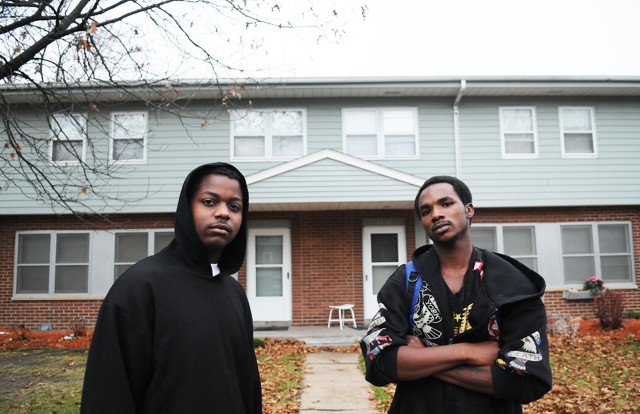Prospect Park is known for historic houses, but rarely is it associated with its Glendale neighborhood, a community that has been home to Somalis for the past 13 years. Although Prospect ParkâÄôs residents are mostly affluent, middle-class homeowners, Glendale has had Native Americans, blacks, Bosnians, Hmong, Vietnamese and Ethiopians pass through the neighborhood. And each culture has left traces of its influence behind. Since 1996, GlendaleâÄôs Somali population and political activism has been growing. âÄúOver the years thereâÄôs been a predominant group,âÄù said Jane Hanger Seeley, the director for family community programs at the East Side Neighborhood Services (ESNS), an agency that has provided social service programming to Glendale since 1970. âÄúAs people get educated and find jobs, they move away. Right now thereâÄôs a process of being predominantly Somalis.âÄù What brought each of these distinct groups to Prospect Park is the Glendale Townhome complex, a public housing project in the corner of the neighborhood. The 184-unit project is owned by the Minneapolis Public Housing Authority (MPHA) and is the only public row house development left in the United States. Janet Smith, the principal asset operatives manager for families at the MPHA said Glendale has always attracted immigrants because of its convenience and facilities, even though the general demography of Prospect Park is more homogenous. âÄúItâÄôs never been this is Prospect Park over here, and youâÄôre just Glendale over there,âÄù she said. âÄúThereâÄôs always been mutual support.âÄù History of Cultural Exchange Seeley said Prospect Park was the only neighborhood in the 1950s that agreed to build public housing for World War II veterans, knowing future immigrants would move into the complex. But there was a stipulation that immigrant families would have to be as active as others in the community. Ann Munt, a retired social worker from ESNS, said she saw the cycle of different groups enter and leave Glendale, starting from the influx of Native Americans in the 1960s. When Hmong immigrants arrived in the 1970s, Munt said there was some tension with Prospect Park residents outside of Glendale, which led to shootings. âÄúIt was [because of] ignorance,âÄù she said. This prompted Munt to organize the cityâÄôs largest cultural exchange between southeast MinneapolisâÄô mostly Hmong, Native American and black population and Northeast MinneapolisâÄô mostly Russian and Italian community. Glendale also had a Hmong cultural celebration, which Munt said broke down walls. âÄúWhen people learned about each otherâÄôs cultures, there was an unbelievable change,âÄù she said. In the 1980s, about 80 percent of GlendaleâÄôs families were Hmong and Vietnamese, which Munt said pressured Pratt school to provide interpreters for parents. ESNS also started a preschool and family education center at Luxton Park. Eventually, the Hmong immigrants left the Glendale neighborhood in the early 1990s after 10 years of being the predominant group. âÄúThe Hmong were able to save up money to buy houses, so naturally people leave,âÄù said Mary Alice Kopf, a real estate agent. Kopf moved to the Prospect Park neighborhood in 1967 when there was a large black community, which was the predominant group for 25 years. âÄúIn those days, there were not a lot of people [from the black community] who could do specific things that they could get paid well for,âÄù she said. âÄúSo they stayed longer.âÄù A few years after the Hmong community left, the first wave of Somali immigrants began settling in Glendale. The community has been there for 13 years, which Kopf attributes to difficulties in finding interest-free loans for mortgages, as mandated by Shariah law. Somali activism in Glendale The tensions with the Hmong community didnâÄôt exist with Somali immigrants because the ESNS started programs to engage the community much sooner, Munt said. In fact, she said the Somali community has been the most integrated and politically active immigrant group in Prospect Park. Somali Women in Minneapolis (SWIM) is a nonprofit group founded by six Somali women from Glendale in 1999. Co-coordinated by Munt, SWIM has been instrumental in meeting the needs of Somali women and other members of the community. With the help of ESNS, SWIM started programs like the local food shelf, free sewing classes and MOVE ON, a program that helps families become homeowners. Safiya Munya, co-founder of SWIM, said the organizationâÄôs food shelf serves the needs of mostly single-mother households in Glendale as well as people from Cedar-Riverside. Besides providing English and family wellness programs, Munt said SWIMâÄôs activism helped keep Pratt School open when it was in danger of being closed by Minneapolis Public Schools. âÄúWe went to every meeting, even in the snow,âÄù Munya said. Thirty members of SWIM also served on the committee to save Pratt school and spoke out against the closure of the school. Last summer, when Pratt school was still in danger of shutting down, Munya said recruiters from Somali charter schools knocked on doors in Glendale to convince parents to send their children to those schools. Some parents had agreed. âÄúWe talked to Glendale residents [and told them] that we have to save Pratt school from closing,âÄù Munya said. âÄúMost kids came back. Some left.âÄù âÄúWe had to go back and recover the kids,âÄù Seeley said. âÄúWe want interaction, and we want people that live in Glendale to be fully engaged in [this] community.âÄù Future challenges There has been a recent influx of more Somalis in Glendale and a decrease in the amount of ESL classes and funding for Pratt school. This worries Munt. âÄú[Somalis] were able to succeed because when they first came until 2004 there was more money in school systems to prepare kids before they went into school settings,âÄù she said. âÄúAnd if those classes are getting cut, thatâÄôs going to be difficult.âÄù She also said the community is getting tired of having to fight against the closure of Pratt School since 1982. âÄúThe school is the hub of our community, and if it goes, our community wonâÄôt be the same,âÄù Munt said.

















